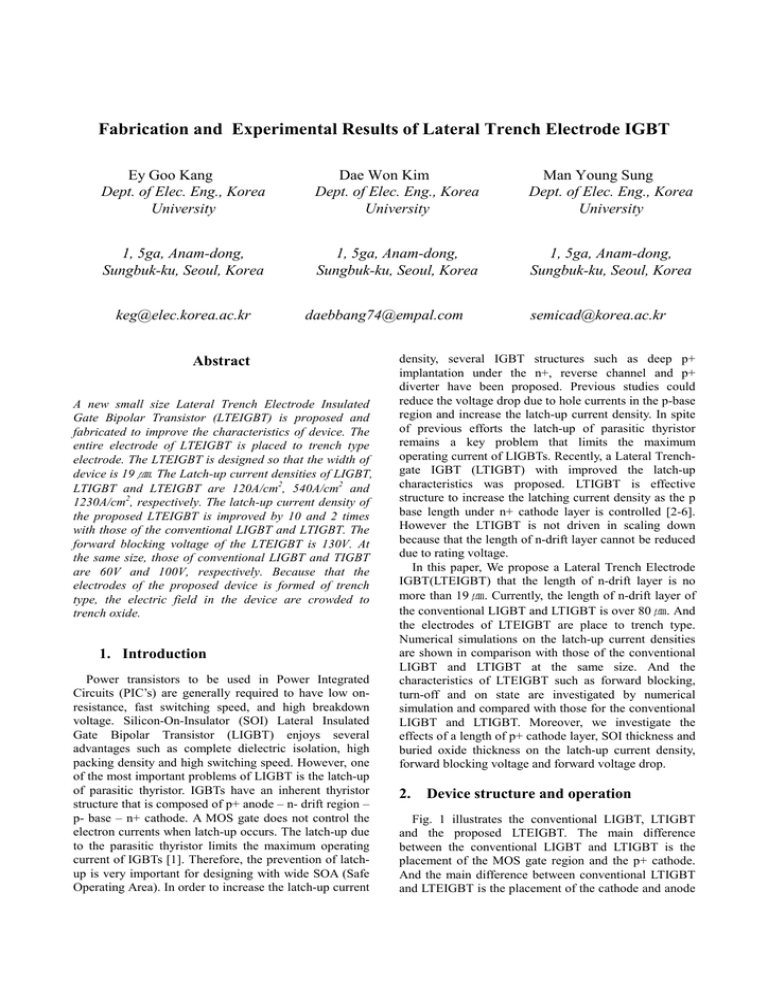Fabrication and Experimental Results of Lateral Trench Electrode
advertisement

Fabrication and Experimental Results of Lateral Trench Electrode IGBT Ey Goo Kang Dept. of Elec. Eng., Korea University Dae Won Kim Dept. of Elec. Eng., Korea University Man Young Sung Dept. of Elec. Eng., Korea University 1, 5ga, Anam-dong, Sungbuk-ku, Seoul, Korea 1, 5ga, Anam-dong, Sungbuk-ku, Seoul, Korea 1, 5ga, Anam-dong, Sungbuk-ku, Seoul, Korea keg@elec.korea.ac.kr daebbang74@empal.com Abstract A new small size Lateral Trench Electrode Insulated Gate Bipolar Transistor (LTEIGBT) is proposed and fabricated to improve the characteristics of device. The entire electrode of LTEIGBT is placed to trench type electrode. The LTEIGBT is designed so that the width of device is 19 . The Latch-up current densities of LIGBT, LTIGBT and LTEIGBT are 120A/cm2, 540A/cm2 and 1230A/cm2, respectively. The latch-up current density of the proposed LTEIGBT is improved by 10 and 2 times with those of the conventional LIGBT and LTIGBT. The forward blocking voltage of the LTEIGBT is 130V. At the same size, those of conventional LIGBT and TIGBT are 60V and 100V, respectively. Because that the electrodes of the proposed device is formed of trench type, the electric field in the device are crowded to trench oxide. 1. Introduction Power transistors to be used in Power Integrated Circuits (PIC’s) are generally required to have low onresistance, fast switching speed, and high breakdown voltage. Silicon-On-Insulator (SOI) Lateral Insulated Gate Bipolar Transistor (LIGBT) enjoys several advantages such as complete dielectric isolation, high packing density and high switching speed. However, one of the most important problems of LIGBT is the latch-up of parasitic thyristor. IGBTs have an inherent thyristor structure that is composed of p+ anode – n- drift region – p- base – n+ cathode. A MOS gate does not control the electron currents when latch-up occurs. The latch-up due to the parasitic thyristor limits the maximum operating current of IGBTs [1]. Therefore, the prevention of latchup is very important for designing with wide SOA (Safe Operating Area). In order to increase the latch-up current semicad@korea.ac.kr density, several IGBT structures such as deep p+ implantation under the n+, reverse channel and p+ diverter have been proposed. Previous studies could reduce the voltage drop due to hole currents in the p-base region and increase the latch-up current density. In spite of previous efforts the latch-up of parasitic thyristor remains a key problem that limits the maximum operating current of LIGBTs. Recently, a Lateral Trenchgate IGBT (LTIGBT) with improved the latch-up characteristics was proposed. LTIGBT is effective structure to increase the latching current density as the p base length under n+ cathode layer is controlled [2-6]. However the LTIGBT is not driven in scaling down because that the length of n-drift layer cannot be reduced due to rating voltage. In this paper, We propose a Lateral Trench Electrode IGBT(LTEIGBT) that the length of n-drift layer is no more than 19 . Currently, the length of n-drift layer of the conventional LIGBT and LTIGBT is over 80 . And the electrodes of LTEIGBT are place to trench type. Numerical simulations on the latch-up current densities are shown in comparison with those of the conventional LIGBT and LTIGBT at the same size. And the characteristics of LTEIGBT such as forward blocking, turn-off and on state are investigated by numerical simulation and compared with those for the conventional LIGBT and LTIGBT. Moreover, we investigate the effects of a length of p+ cathode layer, SOI thickness and buried oxide thickness on the latch-up current density, forward blocking voltage and forward voltage drop. 2. Device structure and operation Fig. 1 illustrates the conventional LIGBT, LTIGBT and the proposed LTEIGBT. The main difference between the conventional LIGBT and LTIGBT is the placement of the MOS gate region and the p+ cathode. And the main difference between conventional LTIGBT and LTEIGBT is the placement of the cathode and anode electrode. As the electrodes of the proposed device are formed of trench structures, it is easy to be made of a small size. Because that the trench oxide layer play a role of mask, it is effective to form n+ cathode and p+ anode junctions, as well. Operation of the LTEIGBT is identical to that of the conventional LTIGBT. In the forward active mode of operation, a positive voltage is applied to the anode relative to the cathode. Anode current starts to flow at gate voltages higher than the threshold voltage and an anode voltage higher than one diode drop. At a higher anode voltage, the anode pn junction starts to turn on and injects holes into the n-drift of the transistor. Some of these holes will recombine with the electrons flowing from the vertical channel, and some of them will flow from the n-drift to the p+ cathode without flowing through p-base layer, directly. So they do not cause. j n 3. Device Fabrication The LTEIGBT were fabricated by employing a CMOS compatible process with a 4-7Ωcm n-type (100) silicon wafer. The n-drift length and depth of LTEIGBT are 19µm and 10µm, respectively. The depth of n-buffer and p-base are 4µm. The depth of n+ anode is 0.5µm. And the depth of p+ cathode is 1µm. The depth of n+ cathode is 0.21µm. The thickness of the gate oxide is 100nm. After the trench process was carried out, the Si wafer was shown in Fig. 2. Fig. 3 shows the plan of surface of the fabricated LTEIGBT. h R R R R T K Figure 2. The cross section of Si-wafer after trench process was carried out (FE-SEM) iGv Tz (a) j h RG n RG RG RG TG TG iGv G (b) h n j Figure 3. The plane of surface of the fabricated LTEIGBT RG RG RG RG TG TG iGv G (c) Figure 1 The cross section of conventional LIGBT, LTIGBT and the proposed LTEIGBT (a) the conventional LIGBT (b) the conventional LTIGBT (c) the proposed LTEIGBT 4. Results and discussion I-V characteristics of the LTEIGBT and the conventional are shown in Fig. 4. . When the gate voltage is applied 12V, the forward conduction currents of the proposed LTEIGBT and the conventional LIGBT are 80mA and 70mA, respectively, at the same breakdown voltage of 150V. In spite of the small size, the forward conduction current of the proposed LTEIGBT is higher than the conventional LIGBT. 0.08 forward blocking voltage of LTEIGBT increased 2 and 1.25 times more than those of the conventional LIGBT and LTIGBT. VG=12V the conventional LIGBT the proposed LTEIGBT 0.07 0.06 LTEIGBT CON-LTIGBT CON-LIGBT VG=10V 0.04 2 Current Density (A/cm ) IAC (A) 0.05 0.03 VG=8V 0.02 VG=6V 0.01 VG=4V 0.00 0.0 0.5 1.0 1.5 2.0 2.5 1 0.1 3.0 VAC (V) 0.01 1E-7 1E-6 1E-5 time (sec) Figure 4. The I-V characteristics of the proposed LTEIGBT and the conventional LIGBt Figure 6. The turn-off times of the proposed LTEIGBT and the conventional devices We have carried out the two dimensional (2-D) device numerical simulation under resistive load by using MEDICI to compare the forward blocking characteristics and the turn-off times of the LTEIGBT and the conventional devices. The turn-off characteristics of LTEIGBT, conventional LIGBT and LTIGBT are shown Fig. 6 . The turn-off times of LTEIGBT, conventional LIGBT and LTIGBT are 0.2 , 4 and 4 , respectively. The proposed LTEIGBT has fastest switching speed. This is reason that LTEIGBT accumulated little minor carriers in n-drift layer because trench oxide layer occupy a part of n-drift region. The current flow lines of the devices at the on state are shown in Fig. 7. It is observed that electrons are flowing from the vertical channel to the n-drift region, and holes are injected from the p+ anode into n-drift region at LTEIGBT. Part of the holes flow from the n-drift layer into the p+ cathode layer. And part of them recombines with electrons flowing in from the channel. The cathode electrode will collect these holes that flow into the p+ cathode layer without causing latch-up. Thus, the area underneath the n+ cathode layer is found to have many holes. On the other hand, the conventional LIGBT and LTIGBT are found to have many holes in its p-base layer in comparison with the LTEIGBT. 0.1 LTEIGBT CON-LTIGBT CON-LIGBT 2 Current Density (A/cm ) 0.01 1E-3 1E-4 1E-5 1E-6 1E-7 -20 0 20 40 60 80 100 120 140 Forward Blocking Voltage (V) Figure 5. The forward blocking characteristics of the proposed LTEIGBT and the conventional devices Fig. 5. is shown to forward blocking characteristics. As length of n-drift layer is reduced, forward blocking voltage is greatly decresed. This is why a small power device cannot be made such as memory device. However, as the electrodes of the proposed device are formed of trench type, the electric field in the device centers toward the trench-oxide layer. Thus, the punch through breakdown is occurred, lately. the forward blocking voltage of same size conventional LIGBT and LTIGBT are no more than 60V and 100V, respectively. But forward blocking voltage of LTEIGBT is 130V. The (a) (b) (c) Figure 7. The current flow lines of the proposed LTEIGBT and the conventional devices (a) the conventional LIGBT (b)the conventional LTIGBT (c) the proposed LTEIGBT 5. Acknowlegement This work is supported by KOSEF(Korea Science and Engineering Foundation) 1999-2-302-017-5 and he Ministry of Science and Technology(2000-J-EH-01-B02). 6. Reference [1] Baligar, B. J.,Power Semiconductor DevicesPWS, 1996), p. 452 [2] B. H. Lee, C. M. Yun, D. S. Byeon, M. K. Han and Y. I. Choi, “ A trench-gate silicon-on-insulator lateral insulated gate bipolar transistor with the p+ cathode well,” in Jpn. J. Appl. Phys. 3, pp. 854-859, 1994 [3] T. P. Chow, “A reverse-channel, high voltage lateral IGBT,” in Proc. ISPSD, pp. 57 –61, 1994 [4] N. Thapar and B. J. Baliga, “An experimental evaluation of the on-state performance of trench IGBT designs,” in Solid State Electronics, Vol. 42, No. 5, pp. 771-776, 1998 [5] Jun Cai, K. O. Sin Johnny, K. T. Mok Philip, “A new lateral trench-gate conductivity modulated power transistor,” in IEEE Trans., Electron Devices, Vol. 46. No. 8, pp. 1778- 1793, 1999 [6] I. Y. Park and Y. I. Choi, “Trench cathode TIGBT with improved latch-up characteristics,” in Physica Scripta., Vol. T79, pp. 337-340, 1999 [7] T. Trajkovic, F. Udrea, G. A. J. Amaratunga, W. I. Milne, S. S. M. Chan, P. R. Waind, J. Thomson and D. E. Crees, “Silicon MOS controlled bipolar power switching devices using trench technology,” in Int. J. Electronics, Vol. 86, No. 10, pp. 1153-1168, 1999 [8] F. Udrea and G. Amaratunga, “The trench insulated gate bipolar transistor a high power switching device,” in Proc. 20th Int. Conference on Microelectronics, pp. 369374, 1995 [9] O. Spulber, E. M. S. Narayanan, S. Hardikar, M. M. De Souza, M. Sweet, and Subhas Chandra Bose J. V., “A Novel Gate Geometry for the IGBT: The Trench Planner Insulated Gate Bipolar Transistor,” in IEEE Electron Device Letters, Vol. 20, No. 11, pp. 580-582, 1999 [10] F. Udrea, S. S. M. Chan, J. Thomson, T. Trajkovic, P. R. Waind, G. A. J, Amaratunga, and D. E. Crees, “1.2kV trench insulated gate bipolar transistors with ultra low on-resistance”, in IEEE Electron Device Letters, Vol. 20, No. 8, pp. 428-430, 1999 [11] B. J. Baliga, “Trench-IGBTs with integrated diverter structures” in Proc. ISPSD, pp. 201-206, 1995 [12] K. Sheng, S. J. Finney and B. W. Williams, “ Improved understanding of IGBT forward conduction,” in Proc., IPEMC, pp. 48-55, 1997




